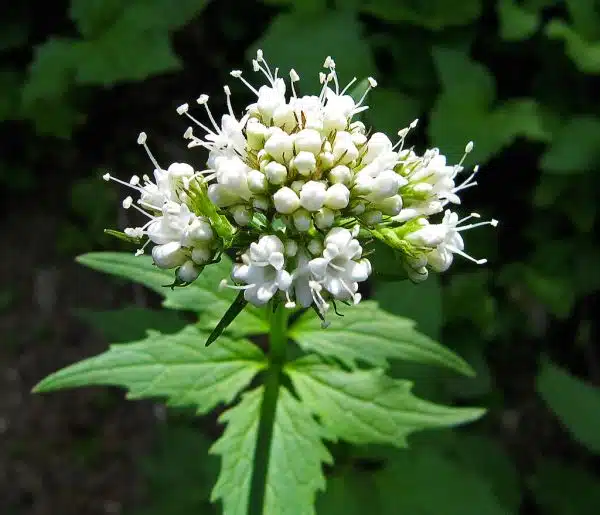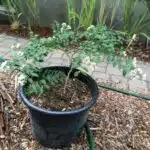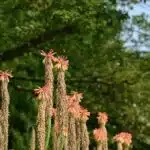Valerian, also known as Valeriana officinalis, is a perennial herb that has been used for centuries in traditional medicine. This plant is native to Europe and Asia and has been naturalized in North America. Valerian has a variety of uses including treating anxiety, insomnia, and digestive issues. In addition, the plant is also commonly used as a sedative and pain reliever.
Growing and caring for valerian can be an enjoyable experience for gardeners who have an interest in medicinal plants. The plant prefers moist soil and partial shade but can also thrive in full sun with well-draining soil. Valerian is relatively easy to grow from seed or division of established plants. Once established, it requires minimal care and attention but should be monitored regularly for pests and diseases. Proper harvesting techniques are crucial for maintaining the potency of the plant’s medicinal properties. By following these guidelines, gardeners can cultivate healthy and productive valerian plants that can provide numerous benefits to their own health and that of others around them.
An Overview Of Valerian
Valerian, also known as Valeriana officinalis, is a perennial flowering plant that belongs to the Caprifoliaceae family. The plant is native to Europe and parts of Asia but has been widely naturalized in North America. Valerian has been used for centuries for its medicinal properties.
The history of valerian can be traced back to ancient Greece and Rome, where it was primarily used as a sedative and sleep aid. In medieval times, valerian was attributed with magical properties and was often used in love potions. During World War I, valerian was used as a substitute for barbiturates to treat soldiers suffering from shell shock.
Today, valerian is still primarily used as a natural remedy for anxiety and insomnia. It works by increasing the levels of GABA (gamma-aminobutyric acid) in the brain, which helps to calm the nervous system. Valerian is also believed to have anti-inflammatory properties and may be useful in treating certain types of pain. Understanding the medicinal properties of valerian can help you make informed decisions about how to care for this plant and use it safely and effectively.
Understanding The Medicinal Properties Of Valerian
Valerian, known scientifically as Valeriana officinalis, is a perennial flowering plant native to Europe and parts of Asia. It has a long history of medicinal use dating back to ancient Greece and Rome. The roots of the valerian plant are commonly used in the production of valerian tea and valerian root extract due to their sedative properties.
Valerian is believed to work by increasing the levels of gamma-aminobutyric acid (GABA) in the brain. GABA is a neurotransmitter that helps regulate nerve activity, promoting relaxation and reducing anxiety. As such, valerian has been traditionally used as a natural remedy for insomnia, anxiety, and stress-related conditions.
In addition to its sedative effects, valerian has also been shown to have anti-inflammatory and antioxidant properties. Some studies suggest that it may even have potential in treating certain neurological disorders such as epilepsy and Parkinson’s disease. However, further research is needed before any definitive conclusions can be drawn about these potential benefits.
- Valerian tea can be made by steeping 1-2 teaspoons of dried valerian root in hot water for 5-10 minutes.
- Valerian root extract can be found in various forms including capsules, tinctures, and powders.
- When taking valerian supplements or using it for medicinal purposes, it’s important to follow dosage instructions carefully.
- Due to its sedative effects, it’s not recommended to drive or operate heavy machinery after consuming valerian.
Understanding the medicinal properties of valerian is key when deciding whether or not it’s right for you. In the following section, we will explore how choosing the right soil can help ensure healthy growth and optimal production from your valerian plants.
Choosing The Right Soil For Valerian
The soil composition is a significant factor that affects the growth and development of Valerian plants. The ideal soil for Valerian should be light, well-draining, and fertile. This plant prefers soils that are moist but not waterlogged, which means it requires proper drainage to avoid the accumulation of excess water.
The pH balance of the soil is also essential for healthy growth. Valerian thrives in slightly acidic to neutral soils with a pH range of 5.5-7.0. If the soil is too acidic or alkaline, it can cause nutrient deficiencies or toxicities in the plant. It’s recommended to test the pH levels of your soil before planting Valerian and adjust it accordingly.
To ensure optimal growth and yield, amending your soil with organic matter such as compost or aged manure can help improve soil structure and fertility. Additionally, incorporating amendments like perlite or vermiculite can aid in improving drainage while retaining moisture at the same time.
Selecting the ideal location for your valerian plants is crucial to their success. In the subsequent section, we will discuss factors such as sunlight exposure and climate considerations that can influence where you choose to plant your Valerian crop. By taking these steps into account, you’ll be able to provide an environment that promotes healthy growth while reducing any potential stressors on your plants.
Selecting The Ideal Location For Your Valerian Plants
After choosing the right soil for valerian, it is now time to look for the ideal location where these plants can thrive. As a herb that requires full sun exposure, it is essential to find an area in your garden that gets at least six hours of sunlight daily. Valerian can also tolerate partial shade, but this will affect its growth and development.
Apart from sunlight, you must also consider the soil acidity of your chosen location. Valerian thrives in neutral to slightly acidic soils with a pH level of 5.5 to 7.0. You can test your garden’s soil acidity using a soil pH testing kit or by sending a sample to a laboratory for analysis.
To help you select the ideal location for your valerian plants, here are some tips and considerations:
- Choose an area with well-draining soil to prevent waterlogging.
- Avoid placing them near areas with strong winds or drafts as this can damage their delicate stems.
- Consider planting them near other herbs like chamomile or lemon balm as they can benefit from each other’s natural insect-repelling properties.
- If you plan on growing valerian in containers, choose pots that are at least 12 inches deep and wide enough to accommodate the plant’s roots.
- Lastly, ensure that the chosen location is easily accessible for watering and maintenance.
With these tips in mind, you can now confidently select the ideal location for your valerian plants. In the following section, we will discuss some useful tips for planting valerian seeds to ensure successful germination and growth.
Tips For Planting Valerian Seeds
Seed starting is the first step in growing valerian. Sow the seeds in early spring, after the last frost date has passed. Start by preparing a seedbed that is well-draining and rich in organic matter. Scatter the seeds evenly over the soil surface and cover with a light layer of soil or compost.
Valerian seeds require light to germinate, so do not bury them too deeply. Keep the soil moist but not waterlogged until germination occurs, which can take up to three weeks. Once the seedlings have emerged, thin them to about 12 inches apart and provide them with regular watering.
Germination techniques such as bottom heat and seed soaking can also improve seedling success rates. For bottom heat, place a seed tray on top of a heating mat or warm surface to encourage faster germination. Soak seeds in water for several hours before planting to soften their hard outer shell and speed up the germination process. With these tips and techniques, planting valerian from seed can be an easy way to start your herb garden.
Moving forward into propagating valerian through division, it is important to note that this method is best done in early spring or fall when plants are dormant.
Propagating Valerian Through Division
Valerian is a popular herb that has been used for centuries due to its medicinal properties. It is commonly grown in gardens and can be propagated through various techniques, including division. Propagating valerian through division is an easy and effective way to increase your plant stock.
Before propagating, it is important to understand the benefits of valerian. This herb has several therapeutic benefits, including promoting relaxation, reducing anxiety, and improving sleep quality. The roots of the plant contain active compounds that have a sedative effect on the body. Valerian is also known to have anti-inflammatory and pain-relieving properties.
Propagation techniques for valerian vary depending on the desired outcome. Division involves separating a mature plant into smaller sections and replanting them in different locations. To propagate valerian through division, start by digging up the entire plant and gently shaking off any excess soil. Next, carefully separate the root clumps into smaller sections using a sharp knife or garden shears. Replant each section in a prepared bed with well-draining soil.
In summary, propagating valerian through division is an easy way to increase your plant stock while reaping its many benefits. Understanding the therapeutic properties of this herb can help guide its cultivation and use in herbal remedies. In the next section, we will discuss proper watering techniques for valerian to ensure optimal growth and health of your plants.
Proper Watering Techniques For Valerian
It is a well-known fact that Valerian does not like to be too thirsty nor too wet. It is almost as if it has a personality of its own, and it can come across as moody when its hydration needs are not met. Therefore, proper watering techniques are essential for the growth and care of this plant.
Watering frequency depends on the climate and the season. During hot summers, when moisture evaporates quickly from the soil, you may need to water your Valerian more often than in cooler seasons. Conversely, overwatering can lead to root rot and other diseases that can harm your plant. To balance hydration for Valerian, we recommend checking the moisture level of soil regularly and adjusting watering frequency accordingly.
Soil moisture is critical in determining how much water Valerian will need at any given time. To avoid creating an environment that fosters fungal growth or disease, it is best to keep the soil moist but not wet. One way to determine if your soil is hydrated enough is to stick your finger into the earth up to about an inch deep; if it comes out dry or slightly moist, then it’s time to water your plant. However, if you feel dampness or sogginess around your fingertip, then wait a bit longer before watering again.
Fertilizing Valerian For Optimal Growth
Valerian is a hardy plant that thrives in various soil types, but for optimal growth, it needs to be fertilized regularly. Fertilization provides the necessary nutrients for the plant to develop healthy roots and foliage. The type of fertilizer used depends on the grower’s preference and availability in their region.
Organic fertilizers are an excellent option for individuals who want to avoid synthetic fertilizers’ harsh chemicals. Examples of organic fertilizers include compost, manure, bone meal, and fish emulsion. These types of fertilizers provide slow-release nutrients that promote healthy growth without harming the environment.
Synthetic fertilizers are also available and can be used to boost valerian’s growth rate. However, growers need to be mindful of the product’s application rates because over-fertilization can lead to stunted growth or even kill the plant. Synthetic fertilizers are usually applied at regular intervals throughout the growing season to ensure consistent nutrient supply.
To sum up, proper fertilization is crucial for valerian’s optimal growth and development. Growers should choose between organic or synthetic fertilizers based on their preferences and availability in their region. They should also follow recommended application rates and schedules to avoid over-fertilization.
Valerian plants benefit from regular pruning sessions as much as they do from proper nutrition. Pruning helps maintain valerian’s shape while promoting health and vigor by removing dead or diseased parts of the plant. In the subsequent section, we will discuss how best to prune valerian plants for optimal results.
Pruning Valerian To Promote Health And Vigor
Valerian, also known as Valeriana officinalis, is a perennial flowering plant that belongs to the Caprifoliaceae family. It is native to Europe and Asia and has been used for medicinal purposes for centuries. Pruning is an essential aspect of growing valerian as it promotes healthy growth, improves the quality of flowers, and prevents diseases. Pruning techniques vary depending on the stage of growth and desired outcome.
Timing for pruning valerian depends on the goal of pruning. The best time to prune valerian is during its dormant phase, which occurs in late fall or early spring. During this time, remove any dead or damaged stems and leaves using pruning shears. If you want to control the size and shape of your plant, you can cut back new shoots by half in mid-summer when they are about 12 inches tall. This will encourage branching and help produce more flowers.
In conclusion, pruning valerian is an important practice that helps promote health and vigor in your plant. Proper timing and techniques can prevent disease, improve flower quality, and control size and shape. In the next section, we will explore identifying and treating common pests and diseases that may affect your valerian plant’s growth.
Identifying And Treating Common Pests And Diseases
One of the challenges that valerian growers face is the presence of pests and diseases. The most common pests that attack valerian are aphids, spider mites, and slugs. These pests can cause significant damage to your plants, leading to stunted growth and reduced yields. Diseases such as root rot, powdery mildew, and bacterial leaf spot can also affect your valerian plants.
Preventative measures are essential in keeping pests and diseases at bay. One way to prevent pests from attacking your valerian plants is by keeping them healthy through proper watering, fertilization, and good air circulation. Regularly inspecting your plants for signs of infestation or disease is also essential in catching any problems early on before they worsen. You can use natural remedies such as neem oil, garlic spray or diatomaceous earth to control pests without harming beneficial insects.
If you notice any signs of pest infestation or disease in your valerian plants, it’s important to act quickly to prevent further damage. Remove any affected leaves or parts of the plant immediately and dispose of them properly. Use organic pesticides or fungicides as a last resort if natural remedies don’t work. Remember always to follow the instructions carefully when using any chemicals on your plants.
To harvest valerian for maximum medicinal benefits, you need to wait until the plant has fully matured before harvesting its roots in autumn or early spring when the top growth has died back. After digging up the roots, clean them thoroughly with water and then dry them slowly at low temperatures (around 30-40°C) until they become hard but not brittle. Store them in airtight containers away from light and heat sources to preserve their potency for future use.
Harvesting Valerian For Maximum Medicinal Benefits
Harvesting valerian at the right time is important to ensure maximum medicinal benefits. The best time to harvest valerian is when the flowers have just opened, and this usually occurs in late July or early August. It is essential to avoid harvesting too early as the roots will not have developed enough of the compound that gives it its medicinal properties.
When harvesting valerian, it is important to use proper techniques to avoid damage to the plant. The roots should be dug up carefully using a garden fork, ensuring that they are not broken or damaged. Once harvested, the roots should be cleaned and cut into small pieces before being dried.
Drying methods for valerian include air drying or using a dehydrator. Air drying involves hanging the roots in a warm, dry place with good ventilation until they are completely dry. A dehydrator can also be used by placing the root pieces on a tray and setting it to a low temperature until completely dry. Once dried, store in an airtight container away from light and heat.
Transition: Now that we understand how to harvest valerian for maximum medicinal benefits let’s move on to learning about drying and storing techniques for later use.
Drying And Storing Valerian For Later Use
Valerian can be dried and stored for later use in a number of ways. To dry valerian, the best procedure is to harvest the plant, hang it upside down in a warm and dark area, and wait until the roots, leaves, and stems are completely dry. After drying, the valerian should be stored in an airtight container in a cool, dark, and dry place. When stored correctly, valerian may remain viable for up to two years.
Drying Valerian
Valerian is a popular herb known for its calming effects on the body. If you want to preserve your valerian harvest for long term use, drying it is essential. Using a dehydrator is the most effective way to dry valerian leaves, flowers and roots. This method ensures that moisture is removed quickly and evenly from the plant material, making it less susceptible to mold growth.
If you don’t have access to a dehydrator, air drying valerian is an alternative option. Simply tie the stems of the plant together and hang them upside down in a warm, well-ventilated area. The leaves, flowers and roots should be fully dry in 2-3 weeks when they become brittle and crumble easily between your fingers.
Once your valerian is fully dried, store it in an airtight container away from heat and light. Properly stored dried valerian can last up to two years without losing potency. To make homemade valerian tea, steep one teaspoon of dried valerian root or leaves in hot water for 5-10 minutes before straining and consuming. With proper drying and storage techniques, you can enjoy the relaxing benefits of valerian all year round.
Storing Valerian
Proper storage of valerian is crucial in preserving its potency for future use. After drying the valerian, it should be stored in an airtight container to protect it from moisture and light. Exposure to heat and sunlight can cause degradation of the plant material, reducing its effectiveness over time.
To ensure maximum freshness, store your dried valerian in a cool, dark place. A pantry or cupboard away from direct sunlight is an ideal location. Additionally, labeling your container with the date of harvest and type of valerian (root, leaf or flower) can help you keep track of its age and properties.
When using stored valerian for tea or other remedies, it’s important to monitor its potency. Over time, the plant material may lose some of its effectiveness. To maintain optimal quality, consider replacing any stored valerian after one year. By following these simple storage tips, you can enjoy the benefits of this calming herb all year round.
Creating Homemade Valerian Supplements And Remedies
Valerian is a popular herb known for its medicinal properties, which can help alleviate anxiety and promote restful sleep. One way to enjoy the benefits of valerian is by creating homemade supplements and remedies. For instance, you can make a valerian tincture by soaking chopped valerian roots in alcohol for several weeks. The recommended dosage of valerian tincture is 1-2 teaspoons up to three times per day.
Another way to consume valerian is through tea. You can brew dried or fresh valerian roots in hot water to create a soothing tea that can help calm your nerves before bedtime. The recommended dosage of valerian tea is 1-2 cups per day, especially if you have trouble sleeping or suffer from anxiety.
Lastly, you can also incorporate valerian into recipes such as smoothies or baked goods. Adding powdered or chopped valerian roots to your favorite recipe can provide a natural source of relaxation and tranquility. However, it’s important to keep in mind the proper valerian dosage when using it in cooking, as too much can cause dizziness and headaches.
Transition: Now that we’ve explored how to create homemade supplements and remedies with valerian, let’s take a closer look at its traditional uses in medicine and modern-day practices.
Valerian In Traditional Medicine And Modern Practice
Valerian is a flowering plant that has been used in traditional medicine for centuries. Its root has been used to treat various ailments such as insomnia, anxiety, and headaches. Modern practitioners have found additional uses for Valerian, including as a mild sedative and as a treatment for depression. Cultivation of Valerian requires well-drained soils, partial shade, and regular watering.
Valerian In Traditional Medicine
Valerian has been used in traditional medicine for thousands of years. Its history can be traced back to ancient Greece and Rome, where it was used as a natural remedy for various ailments. Valerian’s cultural significance extends beyond Europe, with its use being recorded in traditional Chinese medicine and Indian Ayurvedic medicine.
Valerian is known for its calming properties, making it a popular choice for treating anxiety and insomnia. It works by increasing the levels of GABA, a chemical in the brain that promotes relaxation. In addition to its sedative effects, valerian has also been used to treat migraines, menstrual cramps, and digestive issues.
Despite its long history of use in traditional medicine, there is still ongoing research on valerian’s efficacy and potential side effects. As with any herbal remedy or medication, it is important to consult with a healthcare professional before using valerian. However, for those looking for a natural way to promote relaxation and alleviate certain symptoms, valerian may be worth considering as part of a holistic approach to healthcare.
Valerian In Modern Practice
Valerian has been used in traditional medicine for thousands of years, and its popularity continues to this day. Its history can be traced back to ancient Greece and Rome, where it was used as a natural remedy for various ailments. Valerian’s cultural significance extends beyond Europe, with its use being recorded in traditional Chinese medicine and Indian Ayurvedic medicine.
In modern practice, valerian is still known for its calming properties, making it a popular choice for treating anxiety and insomnia. Its sedative effects have been studied extensively, with many studies showing positive results in reducing anxiety and improving sleep quality. Additionally, valerian has been found to be effective in treating certain types of headaches and digestive issues.
While valerian has a long history of use in traditional medicine, it is important to note that it should not be used as a substitute for professional medical advice. It is always recommended to consult with a healthcare professional before using any herbal remedy or medication. However, for those looking for a natural way to promote relaxation and alleviate certain symptoms, valerian may be worth considering as part of a holistic approach to healthcare.
Frequently Asked Questions About Valerian Care And Cultivation
Valerian is a beautiful and delicate herb, which is widely used in herbal medicine for its sedative properties. Valerian propagation can be done by seed or root division, with the latter being the more common method. It is best to plant valerian in the spring or fall, in well-drained soil that is rich in organic matter.
One interesting statistic about valerian is that it has been used for centuries as a natural sleep aid. According to a study published in the Journal of Clinical Sleep Medicine, valerian root was found to improve sleep quality and reduce symptoms of insomnia in participants who took 450-900 mg of valerian extract daily for four weeks. This highlights the effectiveness of valerian as an alternative treatment for those struggling with sleep disorders.
Common valerian problems include fungal diseases, such as powdery mildew and rust, as well as pests like aphids and spider mites. To prevent these issues, it is important to ensure proper air circulation around the plants and to avoid over-watering. If problems do arise, organic methods like neem oil or insecticidal soap can be used to address pest infestations, while copper-based fungicides can help combat fungal diseases.
Valerian care and cultivation requires patience and attention to detail but can be rewarding for those who are passionate about herbal medicine. By following proper propagation techniques and addressing common problems promptly, gardeners can enjoy a thriving valerian crop that provides not only beauty but also valuable health benefits to themselves and others.
Conclusion
Valerian is a fascinating plant that has long been used in traditional medicine to promote relaxation and restful sleep. With its beautiful flowers and strong medicinal properties, it is no wonder that so many people are interested in growing and caring for valerian.
To successfully cultivate valerian, it is important to choose the right soil and location, plant the seeds properly, and take care of the plants as they grow. With a little bit of patience and dedication, you can enjoy a bountiful harvest of this valuable herb.
Valerian truly is a wonder plant – not only does it have incredible medicinal properties that can help with anxiety, insomnia, and other conditions, but it is also surprisingly easy to grow at home. Whether you are an experienced herbalist or just starting out with your own garden, valerian is definitely worth considering as a valuable addition to your collection. So why not give it a try today? Your mind (and body) will thank you for it!
Image Credits
- “Sitka Valerian – Valeriana sitchensis” by pfly (featured)





























